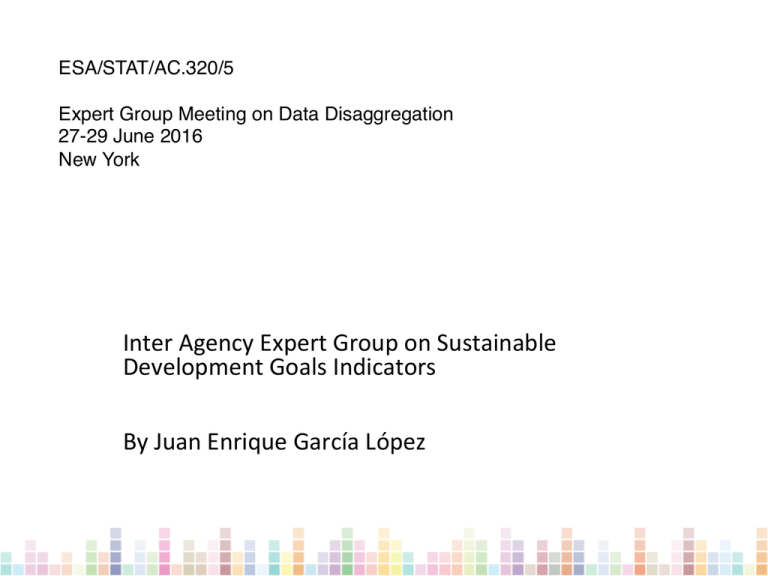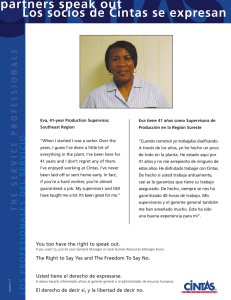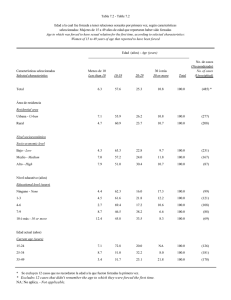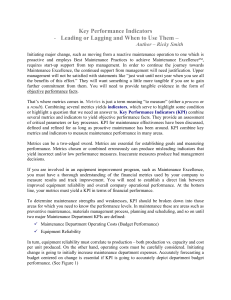Inter Agency Expert Group on Sustainable Development Goals
Anuncio

ESA/STAT/AC.320/5 Expert Group Meeting on Data Disaggregation 27-29 June 2016 New York" Inter Agency Expert Group on Sustainable Development Goals Indicators By Juan Enrique García López " Introduction" Mexico has a Sistema Nacional de Información Estadística y Geográfica (SNIEG), it is a group of institutions (State Units) organized through subsystems, alltogether are coordinated for INEGI and they are articulated by the Red Nacional de Información." SNIEG" Demographic and Social" Geography and environment! Economics" The SNIEG’s goal is produce and spread the Información de Interés Nacional (IIN), this is official and its use is obligatory for Federation, States and Municipalities." Government, public security and justice system! 3" 2030 Agenda for Sustainable Development is ambitious and transformative. The Member States promised to live no one behind.! " The indicators should cover specific groups of population and other disaggregated items as specified in the goals." " SDG indicators should be disaggregated where relevant by income, sex, age, race, ethnicity, migratory status, disability and geographic location, or other characteristics, in accordance with the Fundamental Principles of Official Statistics." " " " 4" In Mexico both the Plan Nacional de Desarrollo 2013-2018 and the Programa Nacional de Estadística y Geografía 2013-2018 consider the Gender issue with a transversal perspective." " These instruments take into account the necessity for special actions aimed at guaranteeing the rights of women to prevent gender differences as a source of inequality, exclusion or discrimination. " " The variable Sex is practically included in all statistics instruments; however, it is necessary to count with variables to construct indicator with a gender perspective.! " " " 5" On September 2015 in the installations of INEGI, Aguascalientes Mex. the XVI Encuentro Internacional de Estadísticas de Género took place. INMUJERES, INEGI, UN Women and ECLAC were the sponsors. At Meeting it was noted that information should have with:" ! Timeliness and relevance. Taking actions to leave no one woman or a girl behind are needed now." Promptness in the collection and analysis of existing data." Innovation the choice of indicators is not solely based on the availability of data, indicators and new methodologies are needed and / or improved." Capabilities. It is essential to improve the technical capabilities and increased investments in support statistical systems." " " 6" Education! Educación En promedio, ¿Cuántos años ha estudiado la población de 15 años y más? Promedio de escolaridad por entidad 2010 8.6 años 2015 9.1 años 8.5 2010 8.8 9.0 2015 9.3 DF NL SON COAH BCS BC AGS QROO SIN QRO MEX COL TAMPS CHIH TAB MOR TLAX JAL NAY DGO CAMP YUC SLP HGO ZAC PUE GTO VER MICH GRO OAX CHIS 11.1 10.2 10.0 9.8 9.8 9.7 9.7 9.6 9.5 9.5 9.5 9.5 9.4 9.4 9.3 9.3 9.2 9.2 9.1 9.1 9.1 8.8 8.8 8.7 8.6 8.5 8.4 8.2 7.9 7.7 7.5 7.3 Municipios o delegaciones con mayor promedio de escolaridad Benito Juárez, Distrito Federal 13.8 Miguel Hidalgo, Distrito Federal 12.9 San Pedro Garza García, Nuevo León 12.7 Coyoacán, Distrito Federal 12.2 San Sebastian Tutla, Oaxaca 12.1 Cuauhtémoc, Distrito Federal 11.9 Tlaxcala, Tlaxcala 11.7 Corregidora, Querétaro 11.4 7" Education! Educación La población analfabeta de 15 años y más ha disminuido en poco más de medio millón entre 2010 y 2015 5 393 665 6.9% 38.5% 4 749 057 Hombres 5.5% Mujeres 2010 61.5% 2015 Analfabetas (población de 15 años y más que no sabe leer y escribir un recado) por grupos de edad y sexo 26.2% 22.5% 18.1% 1.2% 1.3% 5.2% 1.2% 15-29 años 4.1% 6.1% 30-64 años Total Hombres 65 años y más Mujeres 8" Households! Hogares La jefatura femenina aumentó 4 puntos porcentuales entre 2010 y 2015 Hogares con jefatura femenina 2010 2015 6 916 206 9 266 211 29.0% 24.6% 2010 2015 Porcentaje de hogares con jefatura femenina DF GRO MOR SON SIN BC VER TAB CHIH OAX COL CAMP HGO PUE DGO YUC QRO TAMPS NAY JAL GTO MICH MEX BCS QROO SLP TLAX AGS CHIS COAH ZAC NL 35.7 32.7 32.2 31.7 31.6 31.2 30.8 30.5 30.0 29.5 29.3 29.2 28.9 28.8 28.7 28.6 28.4 28.3 28.3 28.1 28.0 27.9 27.8 27.7 27.1 26.9 26.6 26.2 24.3 24.0 23.9 23.6 9" Unpaid Trabajowork! no remunerado En promedio, ¿cuántas horas a la semana se dedican a actividades no remuneradas? Atender a personas sanas menores de 6 años Atender a personas de 60 años y más 34 h 54 m 28 h 21 m 6 h 33 m 21 h 49 m 15 h 39 m 6 h 10 m Atender a personas sanas menores de 6 a 14 años Preparar o servir alimentos para su familia 10 h 48 m 9 h 09 m 1 h 39 m 31 h 20 m 25 h 09 m 6 h 11 m Limpiar su casa, lavar o planchar la ropa de su familia Atender a personas con discapacidad 9 h 26 m 7 h 48 m 1 h 38 m 26 h 18 m 19 h 10 m 7 h 08 m Atender a personas enfermas Hacer las compras para la comida o la limpieza 3 h 46 m 2 h 44 m 1 h 02 m 25 h 36 m 18 h 12 m 7 h 24 m Total Mujeres Hombres 10" International migration! 11" International migration! 12" Unpaid domestic work! 13" 14" 1. Generating sources of information medium and long term to allow the construction of indicators of levels II and III." 2. Innovating methodologies to build gender indicators without having to design large collection instruments that put the quality of information on risk." 3. Ensuring that Data Sources have information that can build indicators with gender perspective, mainly those related to Environmental Issues." 4. Ensuring that indicators and data disaggregation show the aging process mainly in the female population." 15" Conociendo México! 01 800 111 46 34! www.inegi.org.mx! [email protected]! @inegi_informa! INEGI Informa!






